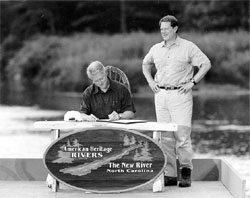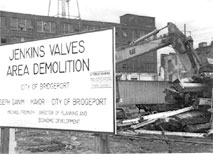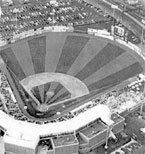 "In the 21st Century, a livable community will be
an economically powerful community...where a high quality of life attracts the
best-educated and trained workers...where good schools and strong families fuel
creativity and productivity...where the best minds and the best companies share
ideas and shape our common future."
"In the 21st Century, a livable community will be
an economically powerful community...where a high quality of life attracts the
best-educated and trained workers...where good schools and strong families fuel
creativity and productivity...where the best minds and the best companies share
ideas and shape our common future."
Vice President Al Gore
September 2, 1998
Photo: Ashe County, North Carolina, July 1998 |
Thirty years ago, the fight for clean air, safe
water, and healthy land was understood simply as a fight for the "environment."
Today, Americans understand that a sound environment is absolutely integral
to their hopes for continued prosperity and a better quality of life.
A healthy environment is the very foundation of a healthy community.
Through a series of initiatives, President Clinton and Vice
President Gore are helping communities across the country take steps that
strengthen both the environment and the economy. New programs to clean up and
redevelop contaminated urban properties are creating jobs and revitalizing
neighborhoods. And increased funding to expand public transit and preserve open
space is helping communities forge new strategies against sprawl.
By providing new tools and resources, the Administration is
expanding the choices available to communities so they can chart their own path
to a more sustainable future.
Livable Communities Initiative
Last year, Vice President Gore launched a new Livable
Communities initiative to coordinate and enhance federal programs that can help
communities grow in ways that ensure a high quality of life and strong,
sustainable economic growth. One of the first steps was creation of a website
— www.livablecommunities.gov —
that provides citizens with a comprehensive guide to tools and resources
available from the federal government. These include programs to encourage
"smart growth," ease traffic congestion, preserve historic structures, protect
farmland, fight crime, and improve water quality.
The Administration secured increased funding for these efforts
this year, and is proposing another increase next year. The new budget proposal
includes $700 million in tax credits over five years for new Better America
Bonds, which would generate $10.75 billion for state, tribal, and local
investments to save green space, create or restore urban parks, protect water
quality, and clean up brownfields.
Revitalizing Brownfields
Brownfields are abandoned properties — often in distressed
urban neighborhoods — suffering real or perceived contamination from past
industrial use. Cleaning up and redeveloping these sites not only breathes new
economic life into inner cities, but also helps preserve green space by easing
development pressures on the urban fringe.
The Clinton-Gore Administration has launched several
initiatives to accelerate the cleanup of brownfields and remove barriers to
their redevelopment. Since 1995, the Administration has removed more than
30,000 of these sites from the Superfund database, relieving potential
developers of unnecessary red tape and removing the stigma of contamination.
More than 300 communities across America have received nearly $70 million in
seed grants, leveraging over $1.6 billion in private investment for cleanup and
redevelopment. As an additional incentive, the Administration secured a tax
incentive allowing businesses to fully deduct certain brownfields cleanup costs
in targeted areas through 2001.
American Heritage Rivers

Blackstone & Woonasquatucket Rivers
(MA, RI)
Connecticut River (CT, VT, NH, MA)
Cuyahoga River (OH)
Detroit River (MI)
Hanalei River (HI)
Hudson River (NY)
Lower
Mississippi River (LA, TN)
New River (NC, VA, WV)
Rio Grande River
(TX)
Potomac River (DC, MD, PA, VA, WV)
St. Johns River (FL)
Upper
Mississippi River
Upper Susquehanna & Lackawanna Rivers (PA)
Willamette River (OR) |
More than 3 million miles of rivers and streams flow
across America, nourishing soil, carrying commerce, sustaining wildlife, and
quenching our thirst. In 1997, President Clinton launched the American Heritage
Rivers initiative to recognize and reward community-based efforts to restore
and protect the environmental, economic, cultural, and historic values of
America's rivers.
Scores of communities in 46 states and the District of Columbia
nominated rivers for designation under the initiative. In 1998, the President
named 14 American Heritage Rivers. The rivers — from New York's
Hudson to the Lower Mississippi to Hawaii's Hanalei — reflect the
extraordinary diversity of America's waterways. Some flow through pristine
forest, others the inner city. Some have been largely restored, while others
remain heavily polluted. For each river, the Administration has appointed a
"river navigator" to help communities identify federal programs and resources
that can assist them in implementing their restoration plans.
Environmental Justice
Historically, low-income and minority communities have borne a
disproportionate share of the pollution and other environmental harm associated
with America's industrial development. In 1994, President Clinton issued
an Executive Order to ensure that low-income citizens and minorities do not
suffer an unfair pollution burden, and that all communities have adequate
environmental protection. The Order directs each federal agency to "make
achieving environmental justice part of its mission by identifying and
addressing disproportionately high and adverse human health effects" its
actions may have on low-income and minority populations. It requires agencies
to prepare environmental justice strategies and to encourage community
participation in their decision-making.
The Administration has also helped spur new investment in
low-income and minority communities through its support of brownfields
redevelopment, expansion of the Low-Income Housing Tax Credit, and designation
of Empowerment Zones and Enterprise Communities.
President's Council on Sustainable Development
Launched in 1993, the President's Council on Sustainable
Development brought together government, corporate and environmental leaders to
develop consensus strategies for meeting America's environmental
challenges in ways that promote continued prosperity, social equity, and a high
quality of life.
Thousands of people across the country contributed to the
Council's deliberations through workshops, conferences, and public
meetings. The Council helped create a national network of community groups
working to promote sustainable development, and was instrumental in building
support within the business community for addressing global climate change. Its
third and final report, Towards a Sustainable America, recommended 140 actions
addressing issues such as sprawl, climate change, urban renewal, and corporate
environmental responsibility. The Council concluded its work last year by
co-sponsoring the National Town Meeting for a Sustainable America in Detroit,
which brought together community and corporate leaders from across the country
to share and learn from each others' experiences.
Promoting Transportation Alternatives
As communities spread further outward and commuting distances
grow, roadways become increasingly congested. According to recent estimates,
nearly half of peak travel time is under congested conditions, and Americans
waste half a billion hours a year stuck in traffic.
To help ease traffic congestion and combat air pollution, the
Clinton-Gore Administration has worked to provide communities with a broader
range of transportation choices. Since 1993, federal funding for buses, light
rail and other forms of transit has risen more than 50 percent, to nearly $5.8
billion this year. The Administration also has won increased funding for bike
paths, high-occupancy vehicle lanes, ridesharing, and other strategies that
reduce both congestion and pollution. For the coming year, President Clinton
has proposed a record $9.1 billion for public transit and other programs to
ease congestion.
Federal Funding for Public Transit
(in millions
of dollars) |
| 1993 |
1994 |
1995 |
1996 |
1997 |
1998 |
1999 |
2000
Estimated |
2001
Proposed |
|
| 3,799,245 |
4,579,265 |
4,606,240 |
4,049,050 |
4,382,511 |
4,843,614 |
5,388,538 |
5,748,915 |
6,321,000 |
|
Bridgeport, Connecticut
On Former Brownfield, A
Championship Ballpark


Baseball
Park |
To the record crowds who fill it, the new downtown stadium
is a place to cheer on their very own championship baseball team. But the
5,500-seat ballpark is also a shining symbol of Bridgeport, Connecticut's
economic revival.
In the early 1990s, Bridgeport was suffering through hard
economic times, and nowhere was the decay more evident than at the old Jenkins
Valve industrial site at the city's main gateway. Like thousands of other
"brownfields" across the country, the site was burdened with industrial
contamination that scared off potential investors.
But with seed money from the Administration's brownfields
program, the city performed a site evaluation that helped attract a developer.
The Zurich Re Corporation invested $11 million in cleanup and redevelopment,
and the city and state kicked in another $3 million. In addition to the
ballpark, home to the minor-league Bridgeport Bluefish, the long-idle site will
eventually house an indoor ice-skating rink and a new museum.
"This is what urban revitalization is all about. This very site
which used to be the scourge of Fairfield County is now the region's most
exciting new entertainment venue," said Mickey Herbert, majority owner of the
Bluefish. "I'd be genuinely surprised if there's a more dramatic
example of success with brownfields reclamation than right here at our ball
park."
Valmeyer, Illinois
Moving to Higher Ground, And a More
Sustainable Future
The Mississippi River floods of 1993 were the costliest in U.S.
history, and few paid a dearer price than the people of Valmeyer, Illinois.
Their town was utterly destroyed.
They decided there was only one way to be sure it wouldn't
happen again: rebuilding the town on higher ground. And while they were at it,
they decided to make the new Valmeyer a model of sustainable development.
One of the places they turned was the Department of Energy,
which dispatched a team of experts to help incorporate state-of-the-art
technologies into the new homes and the new town's design. The state also
pitched in, offering grants of up to $1,700 to homeowners who used
energy-efficient windows, low-flow showerheads and toilets, energy-saving
heating and cooling systems, and other conservation measures.
These and other measures, including solar power, have cut
resident's energy bills about 30 percent. Village Administrator Dennis
Knobloch said the school system, police and fire departments, and other
government offices, are saving around $80,000 a year.
"We feel the effort put forth at the beginning of the process
to involve both state and federal energy departments has really helped to
benefit our citizens," said Knobloch, "and we will be reaping those benefits
for years to come."
This chapter in PDF format
 (438 K)
(438 K)
|

